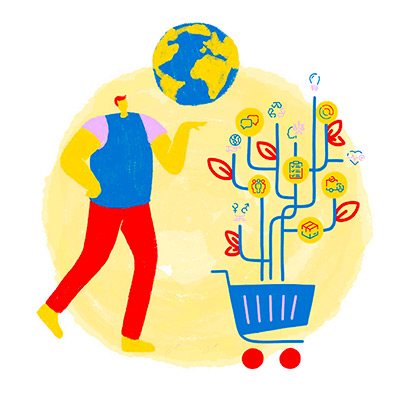The circular economy is attracting growing interest from governments, individuals and organisations. This economic model is appealing due to its ability to reconcile current environmental and economic challenges. On top of helping to preserve natural resources and to reduce pollution and overall environmental impact, it enables smart savings and strengthens the competitiveness of regions. However, this innovation represents a profound change in the paradigm for all these stakeholders, raising the question: Can the circular economy entirely replace the current linear economic system based on the “extract – produce – consume – dispose” model? What are the limitations faced by companies? How can they be overcome? Geoffrey Richard, Circular Economy Director at Schneider Electric, provides insight into these issues.
What are the circular economy limitations for companies?
"The limitations faced by the circular economy are inherent in any organisational and/or structural change within a company. They include human, financial and technical barriers. If not properly addressed, these can slow down or jeopardise a company’s circular transition," explains Geoffrey Richard.
Human limitations
The first obstacle that a company wanting to implement the circular economy may face is the lack of support from employees. By definition, any change involves going through a "grieving" phase. This often triggers emotions within teams, such as fear, anger or sadness, which can transform into resistance.
These barriers concern both operations staff and management. This is why it is essential that everyone fully grasps the stakes of the circular economy, embraces the company’s vision and contributes to collective goals.
Financial limitations
Secondly comes the issue of financial barriers. It should be known that linear models are particularly profitable since they do not account for the negative externalities of their economic activities. This is not the case for circular models. Therefore, within the framework of a traditional business, they may appear as an initial cost centre.
It is important to remind stakeholders that this activity will be lucrative in the long term. Initiating a circular approach can help differentiate companies, attract market share or even increase market capitalisation. Organisations thus need to be prepared to invest without expecting immediate profitability, while looking to the future.
Technical limitations
A further key limitation of the circular economy is technical feasibility. The linear economy is deeply ingrained in our industrial society. Therefore, it can be complex for some companies to reorganise their flows. In addition, some production processes still need to be perfected. Recycling is a telling example. Not all waste can be recycled, not all materials can be salvaged, and recycling channels are not completely environmentally friendly.
There is also a real data issue. Monitoring data, especially that related to environmental impacts (greenhouse gas emissions, energy and raw material consumption, waste management and reduction, sustainable development, etc.) is highly complex. Yet this information is critical to legitimise the approach. In the future, it will be just as vital to ensure compliance with increasing regulations.
How to overcome circular economy challenges?
Fortunately, there are various strategies for getting around the limitations of the circular economy, regardless of their nature. Some best practices are indispensable, such as change management or partnerships, while others depend more on the approach undertaken.
Implement change management
The human limitations of the circular economy need to be addressed through robust change management. This involves raising awareness, informing and training teams. The next step is to build skills across all departments, even training experts who will act as information relays. Finally, it’s about mobilising everyone to commit to this path.
Form partnerships
To make the circular economy a reality, companies need a range of skills and expertise. In most cases, it is impossible to fully internalise a circular economy project. For this reason, it is wise to rely on related organisations that will provide added value.
Communicate externally
When a company launches new circular products or services, it needs to communicate extensively on the subject externally. This is how it generates demand and can implement its first “showcase projects”. These subsequently lead to new contracts with other companies, as economic efficiency is gained.
Operate in “incubator” mode
When a circular activity project risks impacting the business, it can also be isolated in a specific “incubator” type environment. This allows for quick iteration, with all the necessary resources.
By moving forward in complete autonomy, such a project can then be structured more broadly, using processes.
In summary, the challenges of the circular economy are not insurmountable. There are targeted strategies to overcome them and thus sustainably implement the circular economy into a company’s ecosystem. It is now up to each decision maker to take the plunge, in the service of ecology. Especially since the circular economy remains a tremendous lever to strengthen corporate sustainability, both in terms of climate change and economic growth, thereby contributing to long-term growth.





_1110x555.jpeg)


